CALLIBAETIS – PART TWO (Emerger & Adult Dry Fly Imitations)
In part one we covered some of the life history of the species known as Callibaetis; we also covered my favorite wet imitations for this species. In part two we will jump right into my favorite emergers and adult dry fly imitations. Once again, I will provide photo’s of each recipe also with any fly fishing or fly tying tips which come to mind.
I have been using these patterns for a number of years, and over that period of time the patterns have changed very little. You know, if it is not broke, then don’t fix it! Many of my clients have taken these patterns to Argentina where they have also been very effective.
The heaviest hatches of Callibaetis that I encounter on yearly basic occur on still-water fisheries like Quake Lake and Hebgen Lake in Montana. However, I have also encountered Callibaetis on the Upper Madison River and on DePuy Spring Creek, on Yellowstone Lake and the Upper Yellowstone River in Yellowstone National Park, and on the Henry’s Fork of the Snake and on Silver Creek in Idaho.
Now we will move on to my favorite imitations.
The question about imitations is always; “What one do I use?” There is no simple answer to the question. The answer can depend on nothing more that luck, while I enjoy the results of “good luck”, I dislike relying on it.
Knowledge is the best and most consistent friend of the fly fisher.
Learning the various rise forms and learning to observe the trout and how they are feeding will in time give you the best success rate. At times the learning can be a frustrating process but stick with it, learn to be patient and observant, and you will find that it is not as hard as you thought and your success rate will increase.
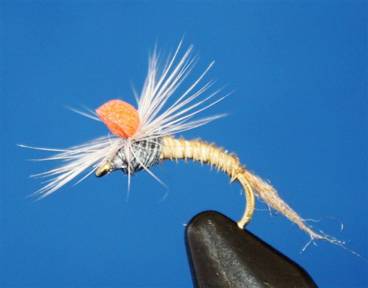
1. Callibaetis Para-Nymph Emerger
- Hook: TMC 2487 Sizes: 14-18
- Thread: 12/0 Sandy Dun
- Tails: Rolled Dubbing Shuck, Scintilla #77 Pale Ginger (as pictured) or Gray Pheasant Tail Fibers
- Abdomen: Callibaetis Turkey Wing Quill Fibers, wrapped
- Wingpost: Dry Cell Fly Foam, almost any color will work, Orange
- Thorax: Gray Pheasant Tail fibers, wrapped
- Hackle: Lite Dun, Dry Fly Hackle, tied parachute style, Grizzly hackle may also be used.
Notes on Pattern #1: Once the actual emergence begins and I see trout feeding on the surface this is the first pattern I will generally select. Chances are that I will fishing a soft hackle, flymph, or spider imitation behind it on a 12” to 20” dropper. I do this because I know that for every emerger that is taken in the surface film, 10 or 15 nymphs or emergers are taken below the surface.
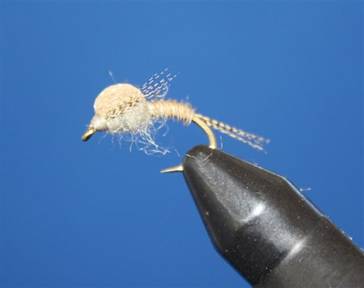
2. Callibaetis Foam Floating Nymph-----Style #2
- Hook: TMC 2487 Sizes: 14-18
- Thread: 12/0 Sandy Dun
- Tails: Wood duck Flank Fibers
- Abdomen: Callibaetis Turkey Wing Quill Fibers
- Wingcases: Gray or Tan Dry Cell Fly Foam, though almost any color would work,
- Thorax: Scintilla #18 Smokey/Olive
Notes on Pattern #2: I prefer to use this pattern when it the water flat calm on a still-water, or very smooth and flat on a stream. I dress the thorax with floatant and grease the leader so it floats. I almost always use this pattern alone and not part of a dropper rig. I tie this imitation on a light wire scud hook. I really like the way this set in the water. After each fish, I thoroughly dry the imitation and redress it. This is not the easiest pattern to see on the water, but you can follow the track of the greased leader. Furthermore, if you see a rise form anywhere near your fly set the hook. What have you got to lose?
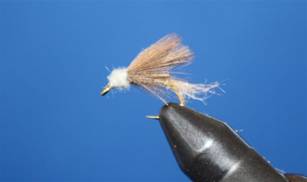
3. CDC Callibaetis Emerger-------Style #2
- Hook: TMC 2487 Sizes: 14-18
- Thread: 12/0 Lite Dun
- Tails: Shuck Rolled Dubbing, Scintilla #77 Pale Ginger
- Abdomen: Callibaetis Turkey Biot
- Wings: Natural Dun, CDC
- Head: Dubbed, Gray Beaver
Notes on Pattern #3: This is another curled type emerger, that I use must in same way a Pattern #2. With the CDC Emerger, I will oftentimes, fish this on a dropper about 24” back from a Paradun.
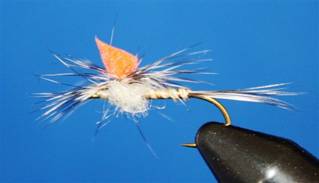
4. Parachute Callibaetis Surface Emerger**
- Hook: TMC 101 Sizes: 14-18
- Thread: 12/0 Sandy Dun
- Tails: Grizzly Dry Fly Hackle Fibers
- Abdomen: Callibaetis Turkey Biot
- Wingpost: Dry Cell Fly Foam, Orange or Yellow (Any Color will work)
- Hackle: Grizzly Dry Fly Hackle, Tied parachute style
- Thorax: Scintilla #10 Transparent Gray
Notes on Pattern #4: This is one of my most effective and versatile patterns in the selection. I use as an emerger, a spent dun and a spinner. Sometimes, I fish it alone, but I will also drop a spider or nymph behind. I suggest tying this with a bright colored foam post to help locate it on the water.
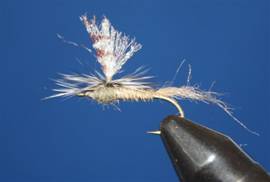
5. Callibaetis Sparkle Para-Dun
- Hook: TMC 101 Sizes: 14-18
- Thread: 12/0 Sandy Dun
- Tails: Shuck, Rolled Dubbing, Scintilla #77 Pale Ginger
- Abdomen: Callibaetis Turkey Wing Quill Fibers
- Wingpost: Lite Dun Saap Wing Material, marked speckled brown
- With a brown marker
- Thorax: Dubbed, Scintilla #18 Smokey/Olive
- Hackle: Grizzly, dry fly hackle, tied parachute style
Notes on Pattern #5: It is a parachute style sparkle dun, so of course it is going to be effective. When I first started fishing Parachute style duns, they were not as popular as they are today. Sometimes, I find that small changes, like a rolled dubbing shuck instead the standard hackle fiber for the tail, can make a world of difference.
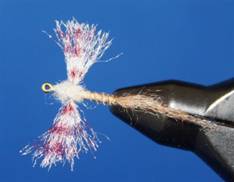
6. Spent Callibaetis Dun
- Hook: TMC 101 Sizes: 14-18
- Thread: 12/0 Sandy Dun
- Tails: Shuck, rolled dubbing, Scintilla #77 Pale Ginger
- Abdomen: Callibaetis Turkey Wing Fibers
- Wings: Lite Dun Saap Wing Material, tied spent, speckled with a brown marker
- Thorax: Scintilla #10 Transparent Gray
Notes on Pattern #6: Wind, rain, even the wave action of a trout rising next to hatching dun can often flatten that dun on the water. Then you add the stillborns or stuck in the shuck half emerged adult and you can see why I have this pattern in my bag of trick. Not only will I use this pattern when the trout a visibly feeding on dun. But I will also use this imitation as the hatch begins to fade and sometimes even after the hatch is over. This is an excellent imitation style which can construct in many different color combinations to cover a great many different hatches. Sometimes, I will fish a spent adult dun and a true spinner imitation during a spinner fall. You would be surprised at how many trout take the spent dun adult all throughout the day. Excellent dry searching pattern.
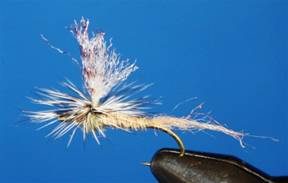
7. Callibaetis Parachute Dun-----Style #2
- Hook: TMC 101 Sizes: 14-18
- Thread: 12/0 Sandy Dun
- Tails: Dry fly, Lite Dun hackle fibers
- Abdomen: Callibaetis Turkey Biot
- Wing: Lite Dun Saap Wing Material,
- Hackle: Dry Fly Lite Dun Hackle, tied parachute style
- Thorax: Dubbing, Scintilla #10 Transparent Gray
Notes on Pattern #7: When they are feeding on the Duns on the surface of the water, this is my favorite pattern. It is easy to see and floats well.
I will also drop wet imitations off this pattern, the length of the dropper will depend on the observation I make and the situation encounter. I have found with Parachute Dry Flies that have a wing post like this pattern, the best method for attaching a dropper strand is off the eye of the hook, rather than the bend of the hook. By attaching the dropper strand to the eye, you ensure that both patterns are presented properly.
I have noticed that when you place the dropper strand off the bend of the hook on this pattern style the dry will tend to fall over on its side.
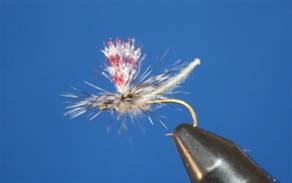
8. Callibaetis Extended Body Paradun
- Hook: TMC 101 Sizes: 14-18
- Thread: 12/0 Lite Dun
- Body Extension: Gray New Dubb
- Wings: Lite Dun Saap Wing Material, Speckled with a brown marker
- Hackle: Grizzly Dry Fly Hackle, Tied Parachute
- Thorax: Dubbed, Muskrat Fur
Notes on Pattern #8: It is always good to have a pattern in the box that is a little different. Besides, this pattern is effective and cute!
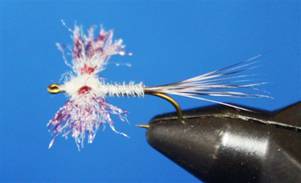
9. Callibaetis Spinner--------Style #2
- Hook: TMC 101 Sizes: 14-18
- Thread: 12/0 Lite Dun
- Tails: Grizzly Dry Fly Hackle Fibers, Tied Long
- Abdomen: Muskrat Gray Turkey Biot
- Wings: Lite Dun Saap Wing Materials, speckled with a brown marker, Tied Spent
- Thorax: Lite Dun, dubbing, Beaver
Notes on Pattern #9: Spinners are among the most under fished, yet effective patterns that the angler carries. Over the years working as a Guide, I have instructed countless number of anglers on the effectiveness of spinner. Besides the obvious spinner falls, spinner imitations are an excellent searching pattern. If you have problems seeing the spinner, fish it behind a Paradun as a dropper!
I hope these patterns work as well for you as they do for me.
Enjoy & Good Fishin’
From the Desk of the Wandering Fly Tyer
